
|   |

|   |
e-mail: khokar1960@gmail.com Dance Academies and academics April 12, 2016 Lectures, baithaks, small gatherings, conferences and academic discussions - this is what my wish-list was 5/7 years ago and so we started Dance DISCourse at Alliance Francaise de Bangalore, under the enlightened presidentship of former Chief Secretary Shri Chiranjiv Singh, also our former ambassador to UNESCO, Culture and Finance Secretary. And today all over India, this trend has caught on and now it is happening. Nay, trending! I'm happy to report, in the last few years, a concerted effort has led to discussion and debate on dance issues. Of course, I'm not saying this was not the case before but it is more focused and academic now. Earlier, it was about person (personal) and now we have helped change the discourse to professional issues. About history and heritage; icons and pioneers. Not just my-school-or-bani-or-gharana-is-better-than-yours approach but about origins and provenance, future and trends. Pune, Baroda, Delhi, Sonepat (Jaatland!), Madras, Trichy, Bangalore. All major dance cities and minor ones, are increasingly feeling the need to talk about dance not just view dance. People are tired of seeing more and more dancers on stage (without finish or content, just going through the paces) and now wish to connect with the core of dance as a subject. 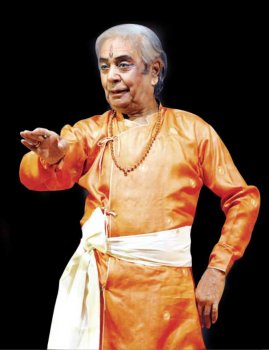 Birju Maharaj So after a huge week-long Baani Conference in Kalakshetra, Madras, I land in Baroda where the ever-energetic doer of dance, Dr. Parul Shah (ex-dean of the dance dept, MSU, that my father helped start and headed in 1950s) is putting final touches to her tome -- e-pathashala for the UGC (future students living far from the maddening crowds, can study dance on the net!). I arrive in Delhi and there is the King of Kathak – pundit, guru, doyenne, the great Birju Maharaj doing a baithak (intimate sit-down interactive dialogue) with 100 students of Saraswati College (old timers Delhites would recall there was only one recording studio tucked in the bylanes of Daryaganj, yes the same family). The baithak is on ganda-bandh or tying of sacred thread on wrist of a shishya. This is a very symbolic bond between a guru who ADOPTS a shishya. Not merely for teaching an art form like dance but adopts as family. In his lifetime, he shared in this baithak he had done only 8 such ganda bandhs: Pratap Pawar was first such case and his nephew (sister's son) Munnalal Shukla, who is also a guru of renown (having taught for 50 years, folks like Neera Batra and Neelima Azim better known as Shaheed Kapoor's mother! and now Ruchi Saini, who hosted the baithak at her Saraswati College cum residence abutting a DDA designated park in the now posh SDA area) are renowned male dancers-teachers and Saswati Sen, who for decades has managed Maharaj-ji's life and work, teaching and travelling, outreach and schedules. She is his shadow. She serves him like few have served their gurus. Maharaj-ji once said: “Saswati has put her own career on hold for mine.” Ultimate praise and blessing from a great guru, a giant. 100 eager children with parents sit and listen to him, though from my vantage point, I see some busy on their cells doing WhatsApp! Why should cells be allowed in class? Why do parents buy their kids expensive cells but rarely a book on dance? 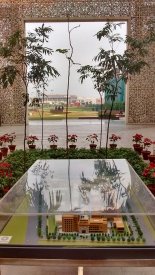 Ashoka University Pic: Ashish Khokar 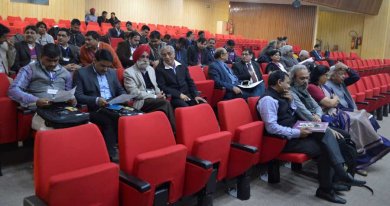 Left-Right: Vineet Gupta (Pro-VC of Ashoka Univ), Ashish Khokar, Gopa Sabharwal (VC of Nalanda) and Ashok Vajpeyi Delhi has grown and how! Being the capital, it has an advantage of much resources and taking hinterland of other adjoining states like U.P or Haryana. So, earlier last month I was invited to the most happening Liberal Arts University called Ashoka, an hour's drive from Delhi on NH 1 (and got stuck there due to jaat protests and siege of all highways leading in and out of Delhi). At Rai, the Haryana govt, under the former CM Hooda, had given hundreds of acres of land for an "educational SEZ" named after Rajiv Gandhi. Many universities have sprung up here, each more fancy and modern than the other but Ashoka tops the list for us in arts field because the promoters (three do gooders) created it trying to save Indian kids having to go abroad and paying a ransom in fee. Ashoka Univ, like Nalanda, boasts of Indian "stuff", the Buddhist studies, arts, aesthetics and all. So both the heads or Vice Chancellors, Gopa Sabharwal of Nalanda and Vineet Gupta of Ashoka, in attendance to the UN Info Centre, sponsored a seminar on Preserving Heritage and Libraries Conference (to which one star dancer - Geeta Chandran - and one dance historian - yours truly - were invited too). Ashok Vajpayi is a good story-teller and delights all with his tales, smile and puns. The day-long discussions showcased where library science stands today and how private archivists are helping save and secure our heritage, including Collections like Mohan Khokar's or Baroda School of Painters like K.Subrahmanyam. Many educative presentations were made and it was a meaningful gathering. SAGE books had set up a massive table with all their titles and in the end of day-long talks and tokenism, I asked the sad-looking salesman how were the sales? He said, "Sir, not a single book has sold. Worse, no librarian came and saw, leave alone ordered." So much for our love for books! As a race, we Indians don't buy books. Ask me, after 18 years of bringing out India's only yearbook on dance (and 20 others titles), I know how difficult it is. And majority of our dancers don't read anything unless it is on them and that too, flattering! And for the uneducated under 30s generation, Facebook has replaced real books. They are so busy and happy reading what they have written and posted. 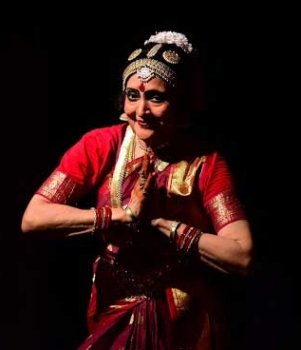 Vyjayanthimala Photo: Ganesh Ramalingam Two cities alone stand out in India for book loving people, judging by the number of bookshops (that's a realistic barometer): Bangalore has over 30 bookshops and Madras 20. And max dance books sell in these two cities. Period. I have a firsthand experience. Bombay and Delhi have much more money but fewer bookshops and most denizens love their account and cheque books more than real books, often! Kolkata was the original city of book lovers (and writers!). Thus, naturally, an academically inclined city like Madras and an established institution like Kalakshetra, thought of doing a grand focus on Baanis of Bharatanatyam in mid March, with quality and content. Coming close on the heels of Remembering Rukmini Devi festival a fortnight before (to coincide with her 29th Feb birthday), the Baani Conference was a major academic event in recent years, not only of Madras, but India. Here is an institution, that is slowly coming out of coma and now the world is coming to see a new child being born. Two years into her job as director of this citadel of an institution, Priyadarsini Govind has shown her mettle and material. When she took over, many in the cruel, cruel dance world wondered if she would be able to manage since she was unknown in arts administration, with no real, national background and experience in running an institution of this scale but she has proven most critics wrong and maybe her lack of previous experience has made her less biased or judgemental and that's helped her be open and inclusive. She has slowly won every senior guru's heart and head and now she has much support and the place shows results. All gurus attended most days they could. A readymade student audience filled the huge thatched roof hall and punctuality and perfection marked the few events I attended. The quality of acoustics, mike and all, were excellent. Students, volunteers, staff smiling for days on end and a team of devoted doers ran the whole event, seamlessly. Priya has inculcated team work, discipline and aesthetics. What stood out in Rukmini Remembered was the woman's sheer vastness of mind and attitude. Haven't we learnt anything from it? What have we made of her legacy? In schooling, in vegetarianism, in love for animals. Her vision was not just about teaching dance. It was about teaching values. Kalakshetra is limping back to normalcy after years of near comatose existence. 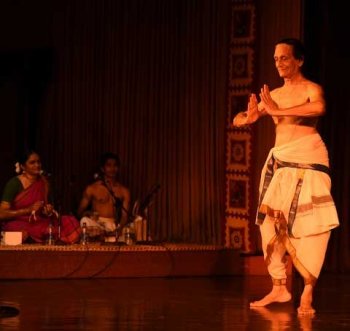 CV Chandrasekhar Photo: R Prasana 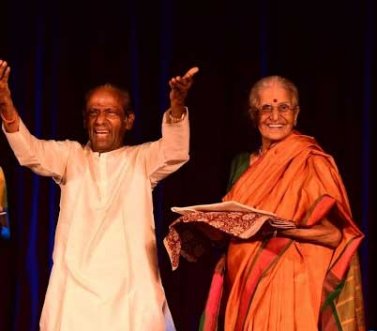 Kalyanasundaram-Jayalakshmi Photo: Ganesh Ramalingam 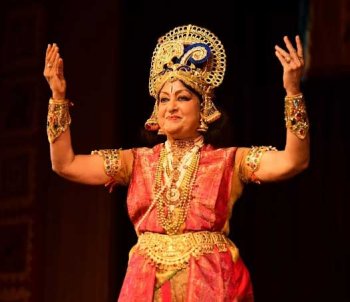 Padma Subrahmanyam Photo: R Prasana 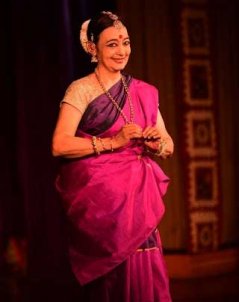 Sudharani Raghupathy Photo: Ganesh Ramalingam  Balagopal, Janardhanan, VP Dhananjayan, Shanta Dhananjayan Photos: Ganesh Ramalingam Baani photos courtesy: Kalakshetra Archives The Baani Conference was a rich feast. Seven days almost of nonstop academic content. Wah! Opening and closing ceremony full of rich dance memories and material from reputed Guru Kalyanasundaram (better known as Badshah of Bombay Bharatanatyam and guru of stars like Vani Ganapathy and Malavika Sarukkai, amongst others. But for his family - brother and baani - Bombay would be much poorer for want of BN), and guru Dhananjayan, both representing a continuity. Add Sujatha Vijayaraghavan's excellently illustrated talk on popular guru Ramaiah Pillai and V.A K. Ranga Rao's feast on films and dance, the morning sessions were meaningful. Some just danced an item like Urmila Satyanarayanan and left without talking much but some talked too much and little came of their dance, like Bragha Bessell. Best demos came from least known and expected dancers like multi-talented singer-nattuvanar-dancer-guru Suresh, or from small town India. All the divas and diyas of dance were in attendance daily, shining in their silks and their skins glowing with spa oils and steam baths. In Chennai, because of staid lifestyle, 70 years old look like 45! The Padma Subrahmanyams, the Lakshmi Vishwanathans, the Kalyanasundarams all look half their age. Those fully involved with dance, glow with an inner shine. Their life is about art. The Baani mornings concluded with a 15 minute Panel Talk each day, which was made up of young India and thank god for that. One gets tired of hearing the same drivel by seniors on most forums, so Priya had included many young voices. The Anjanas, Aniruddhs, Abhilashes. The Nityabharatis, Nityasumangalis and Nityanandinis! They had two minutes to speak (after 4 hours of morning lec-dem talk sessions, two minute each was best for all) and each spoke meaningfully. A new wind is blowing in a moribund place like Kalakshetra, which is now hot and happening. Students like Eklavya from Delhi, not knowing a word of Tamil, Sanskrit or Telugu tell me they have come to learn "culture". Good enough. Many PYTs from Bhubaneswar, Baroda or Boston are here and I ask them why not learn their own regional style in their home settings? "No sir, BN is best! And Kalakshetra is best! Sir, our own stars came to this place and became famous” (one referring to Sanjukta Panigrahi, the Odissi diva who also learnt BN at Kalakshetra), so this is a point I take up in my session (on one of the fountainheads of BN, guru Muthukumaran Pillai, the other being Guru Meenakshi Sundaram Pillai) that don't learn to earn or become famous. Learn to become the art form. Live it. Many senior gurus later said what you said, "We can't say on stage." Madras can be so-oo cautious and correct. That's why society needs critics and historians -- to assess. All is not 24 carat gold; only a jeweller can tell the difference and value of each metal. Likewise, anyone who learns some dance is not a dancer, just a practitioner. In my session (much viewed from Sweden to Seattle because Kalakshetra was smart to webcast it and still can be seen on Utube - all days all sessions and shows, not just mine), I pointed to each sitting guru and star of BN in front rows and between them they formed 1000 years of BN. That the "unpretentious doyenne of BN", veteran M.K. Saroja (my dear mother) came to attend this session was heartening because she entered Kalakshetra after 60 years! Why after 60 years? That's another story for another time. She came not so much for me but for her guru who was that session being spoken about. This is guru bhakti. 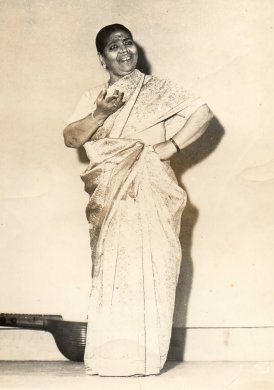 Swarna Saraswati ; Photo: Mohan Khokar 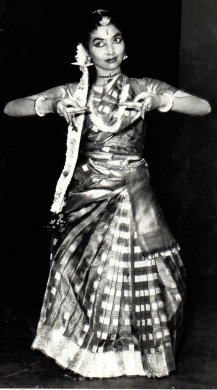 Yamini Krishnamurthy ; Photo: Mohan Khokar The Baani Conference also left one a bit disturbed. While Madras is the citadel of Bharatanatyam, why two sessions on Kalanidhi Narayanan and none on many others like Mylapore Gowri or Swarna Saraswati? Does anyone in current generation even know of Swarna Saraswati in Madras? Or remembers her? A giant talent from devadasi sampradaya, she married Hotelier Everest Sundaram and left Madras when they were shunned by natives and they shifted to Delhi in the 1960s. In Delhi, she lived a simple life in Karol Bagh (where in the 60s lots of Tamilians had made base, so the eco system was there). This queen of abhinaya died unsung but still left many star students (Hema Rajgopalan in Chicago; Shanta Raghavan and later Geeta Chandran in Delhi and many more). Look at her photo here, taken by Mohan Khokar. She did this abhinaya-intensive dance 30 years before Kalanidhi Narayanan even returned to stage. In Khokar Archives there exists ample proof. Photos are just one. Or take for example the new Baroda baani doing BN to Gujarati composers (Parul Shah) or Parvathi Kumar's much work in "Marathi" baani as represented by Sucheta Chapekar ? Too much on Ramiah Pillai (by many reps, students of students too!) and not much on Meenakshi Sundaram Pillai? In my session, had I not shown my film featuring many greats like Meenakshi Sundram Pillai, Mrinalini Sarabhai, Ram Gopal, Shanta Rao, Yamini, all would have been forgotten on this forum. Yamini Krishnamurthy - Padma Vibhushan no less now - would have enhanced the proceedings. She is the best brand of Kalakshetra itself, not BN alone. Leela Samson also was seen nowhere, neither any of her students or works. Add many such luminaries. Anita Ratnam is a global voice for Indian dance and BN. The Chandralekha brand; she demystified BN. I know it is impossible to get all on same page, in same city and at the same time. So next time! The Ides of March rolled on. Now with April on us, the World Dance Day celebrations will start seriously! Delhi has two days at IIC lined up; Bangalore, for last 5 years, boasts of "largest single-day gathering" at Alliance Francaise and for sure Bombay, Bhubaneswar, Baroda will not be far behind. Dance is indeed trending! In all this, at laid back Pondi, a dance residency was held by a Belgium choreographic company and school called P.A.R.T.S. They are the biggest educators in contemporary dance Europe now. They select dancers and budding choreographers from the world over and keep them in their Brussels HQ, where they learn more, dance, create, ideate! A bright Punjabi called Sujata Goel, who learnt BN from the Dhananjayans and Kalakshetra 20 years ago and then was with Padmini Chettur, now living in Pennsylvania, put together this whole 6 week dance residency camp at Adishakti in Pondi, where scholars like Pappu Venugopal Rao, B.M. Sundaram and yours truly dialogued with student-dancers on respective special interest areas. P.A.R.T.S had selected 12 Indian student-level dancers and 12 from various countries like Costa Rica, France, England, Morocco, Belgium, Russia and made them stay together to learn from each other too. This is best way of cultural exchange. 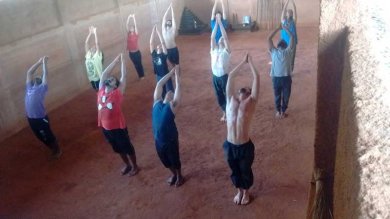 P.A.R.T.S residency at Adishakti Photo: Ashish Khokar Adishakti is Veenapani Chawla's baby now run by Vinay and Nimmy. The Trust ought to run the place professionally because it has great potential. Such national luminaries as Rajeev Sethi are trustees. Just a good theatre (though hot and humid, as Pondi is by the sea) is not enough or a nice swimming pool (from theatre to pool?). The whole Pondi place reeks of inverse racism. Indians are not welcome, even Tamilians, in whose land they are! The entire eco system is geared to fleece the foreigners. Adishakti is part of this eco system. The place is well positioned but rather poorly run. Food is horrible (if foreigners and that includes Punjabis and Manipuris,not just white skins, are to PAY and stay, then they simply can't eat pongal or bhaat for breakfast and mashed bhindis for lunch and runny tasteless sambar for dinner for days on end!). Adishakti was a good idea but needs proper management. Their recent work ‘Ganapati' was disappointing too. I saw it at SPACES in Madras, and this latest production of Adishakti had low content. The opening sequence was to die for (such splendid lighting) but just good lights and sound don't make theatre. Ganapati played to the gallery and a foreigner with saxophone dominated the second half. Maybe a case of Ganapati blowing his own trumpet but it became bit of a solo jazz show. For me, Veenapani's works (like Savitri) had a centre, she was very centred. Adishakti productions and works now lack that centre. A good idea lost? Lost, young modern dancers of India are. Most think a leg of kalari, a mudra of BN makes Indian dance modern. They are on stage clueless and look to west for ideas to copy. Foreign pedagogy also likes to define and demarcate histories; modern, post modern, neo classical etc. Why? Let dance be dance. We need to start a proper Indian Modern Dance college or university. This mish-mash being tom tommed today simply won't do. Anyone out there? We also need to inform the generation next of what has happened in recent past. Most are clueless. There is no real set up to teach dance history or heritage. In absence of one, I'm going from place to place, dance centre to dance institution, university, NGOs, studios, teaching dance history and sharing rare visual materials. This month alone, I have 4 such lectures (LshVa, Jaina Univ, Alliance Francaise - all in Bangalore, and in Trichy; In May, Brussels, Berlin, Bombay). I'm becoming a pracharak of Indian values through dance! When I meet students, many don't know basics. I ask, what does Alarippu mean? Answer is a blank. What does Padam signify? Blank. At best, "Items, sir!" they say. Many don't even know why we touch feet of gurus! It is time we link up traditional symbols and value systems with our arts. The two have a disconnect and young India has a total disconnect with Indian culture. 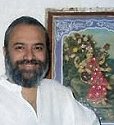 Ashish Mohan Khokar is a reputed dance historian, biographer, critic and author of many published articles and books on Indian arts and culture. He served govt. bodies in many capacities and also teaches Indian dance history and aesthetics for university faculties. He is the curator of the Mohan Khokar Dance Collection and chairs the Dance History Society which hosts an annual convention and dance discourses that afford many talents a platform. He has mentored many and instituted five awards through attendance, the dance yearbook he edits and publishes. Comments Loved the article. Learnt a lot. Good observations. Would like to know more about Swarna Saraswathy! - Tapati Chowdhurie (April 19, 2016) Post your comments Pl provide your name and email id along with your comment. All appropriate comments posted with name and email id in the blog will also be featured in the site. |